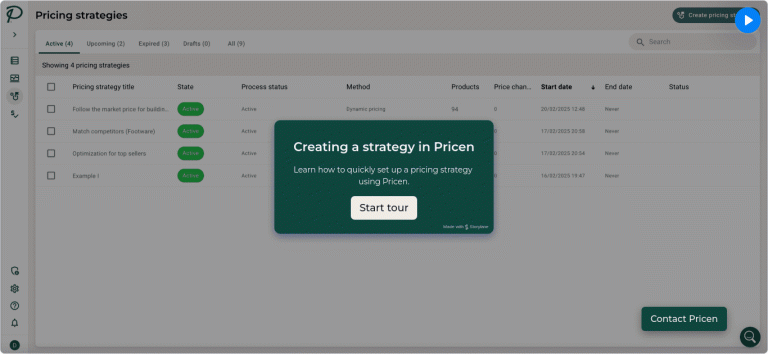So you’ve decided your pricing team needs better tools. Smart move. But now comes the part that trips up even the most experienced retail pricing leaders: the Request for Proposal (RFP).
On paper, an RFP looks simple: write down what you need, get vendors to respond, pick the best one. In reality? It’s often a flood of templated responses, vague promises, and demos that don’t solve your real-world pricing challenges.
The quality of the RFP determines the quality of the conversation that follows. A clear, specific, and well-structured RFP doesn’t just help vendors understand what you need. It helps you uncover what really matters to you and your team and avoid months of misalignment.
So if you’re a Pricing Director or leader preparing for a software search, this guide is made for you. It breaks down the critical components of an effective pricing RFP. Let’s get into it.
What is an RFP and why does it matter
A Request for Proposal (RFP) is a formal document that articulates your organization’s specific needs and expectations related to software, inviting vendors to submit their solutions.
It forces clarity, surfaces priorities, and sets the tone for the rest of your software selection journey. It’s a great tool for alignment within your own team and with potential partners, and it matters for three main reasons:
1. It sets the terms of engagement
A strong RFP tells vendors exactly what you’re trying to achieve, not just what features you want. It lays out your pricing objectives, the operational context, and the outcomes that matter. That clarity helps vendors tailor their responses and ensures your internal stakeholders are aligned from day one.
2. It creates useful pressure
When vendors know they’re in a competitive process with clear evaluation criteria, they bring their A-game. That means more thoughtful proposals, sharper pricing, and better demos.
3. It reduces risk later
Ambiguity in the RFP phase creates friction later. If the vendor doesn’t understand your data realities, team workflows, or pricing priorities upfront, you’re in for surprises during implementation. A solid RFP minimizes that risk and saves you headaches down the line.
Key factors of a winning RFP
To prepare a detailed and effective RFP document tailored specifically for pricing software, you must incorporate several key elements:
- Project goals
- Requested features
- Vendor qualifications
- Budget and constraints
1. Project goals
Before you get into features, frame the big picture. What are you actually trying to achieve?
Some common goals we see from retail pricing teams:
Margin optimization: Using data-driven pricing to increase profitability without decreasing demand
Dynamic pricing: Adapting to inventory, seasonality, or competitor changes in real time
Cross-channel consistency: Ensuring pricing logic holds across e-commerce, stores, marketplaces, and apps
- Promo optimization: Creating automated promos with optimized discount levels for improved margins
2. Request the right features
Incorporate a checklist of critical features that the pricing software must possess. Suggested features include:
Price optimization algorithms: Ask what kind of models are used, how they handle elasticity, and how configurable they are.
Data and analytics: Ensure the software can extract actionable insights from extensive market and sales data.
System integration: Be explicit about your tech stack and data workflows. The integration conversation needs to happen now, not later. This is a key conversation to have.
User experience: We know that pricing teams don’t have time for clunky tools. Ask to see a live UI walkthrough or to get an interactive demo.
Execution and control features: Support for approval workflows, channel-specific pricing, and business rules (floor/ceiling logic, rounding, overrides). The right platform should help you scale governance, not create more work.
Support and roadmap: Who’s behind the product? Will you get a helpdesk or a partner?
These are, of course, just examples. Your feature needs may differ, and your feature list should reflect the complexity, speed, and priorities of your own organization.
Tip: Incorporate user stories. Go beyond features: describe real scenarios your team encounters.
3. Define what makes a vendor qualified
When it comes to vendor selection, experience matters, but specifics matter more.
Focus on qualifications that go beyond the usual slide decks and surface-level claims. Look for real evidence that the vendor understands the retail pricing landscape and can support your business through complexity and change.
Key areas to assess:
Relevant industry experience: Has the vendor worked with retailers that share similar pricing challenges, assortment size, or go-to-market complexity? Ask about comparable clients.
Client references and case studies: Request references you can speak with directly. Even better: look for case studies that show how the platform performed post-implementation.
Track record of delivery: Has the vendor executed successfully in environments like yours? Consider implementation timelines, team structure, and ongoing support models.
4. Budgetary considerations
Pricing software is an investment in profitability infrastructure. That said, you still need clarity and alignment on cost from the outset.
Presenting a clear budget outline helps keep vendor proposals aligned with your financial constraints. It is crucial to detail both initial costs and ongoing expenses related to maintenance, support, and upgrades. Addressing these parameters early prevents potential misunderstandings related to financial commitments later in the procurement process.
Take a spin on our interactive demo, or contact us directly to see how Pricen can work for you.

The RFP process
The best RFPs don’t just show up in inboxes fully formed. They’re the result of thoughtful prep, internal alignment, and clear communication with vendors. Here’s how you should run the process step by step:
1. Preparation
Get initial input from the right people. Form a cross-functional working group that includes pricing, finance, IT, and commercial teams; anyone whose workflows or KPIs intersect with pricing.
This isn’t just to gather input. It’s to uncover roadblocks early (like integration constraints or data challenges) and build buy-in before you’re evaluating solutions.
Some questions to align on:
What are the workflows we need improving?
What systems and data do we need to connect?
What KPIs do we need to reach post-implementation?
2. Drafting the RFP
Structure your RFP clearly and logically. Use the components we covered earlier as your foundation. Include:
A brief introduction: Who you are, what you’re looking for, and what success looks like.
Clear project goals: Tie your objectives to business outcomes, like margin increase, price execution speed, stock rotation, etc.
Feature checklist and requirements: Include both must-haves and nice-to-haves. Make sure vendors can easily respond in a structured way. Incorporating user stories also goes a long way.
Submission instructions and timeline: Define what’s required in the response (docs, demos, case studies), when it’s due, and who to contact.
You want to reduce ambiguity. The more precise your language, the stronger and more relevant the proposals you’ll get.
3. Issuing the RFP
Send the RFP to your curated list of vendors and set expectations from day one.
Be clear on deadlines, milestones, and how questions will be handled.
Let vendors know how decisions will be made and when shortlisting or demo stages will occur.
Maintain professionalism but also aim to keep it collaborative. A good RFP process is the start of a great partnership!
Evaluating proposals
When the proposals start landing in your inbox, it can be tempting to get caught up in shiny features and polished decks. But your job is to evaluate each vendor’s ability to deliver real business value. Some tips:
Build a scoring framework
Start by creating a weighted scoring matrix that reflects your priorities. That way each proposal gets scored against categories important for you. This quantifies decision-making and helps avoid bias. For example:
| Criteria | Weight (%) |
|---|---|
| Alignment with project goals | 30% |
| Feature set & functionalities | 25% |
| Integration capabilities | 20% |
| User experience & UI | 15% |
| Vendor support & roadmap | 10% |
Must-haves vs. nice-to-haves
Before reviewing, you could categorize your requirements into “must-haves” and “nice-to-haves.” That way you can disqualify proposals that miss your important must-haves and save time.
How did you like the demo?
Alongside scoring sheets, make room for subjective impressions: did the vendor’s team understand your challenges? Was the demo intuitive? These insights often reveal critical factors beyond features.
Document it all
Keep notes on each vendor’s strengths, concerns, and follow-up questions. This helps later when you’re justifying your shortlist or final decision internally.
Setting up this evaluation rigor early ensures you focus on what really matters: selecting a pricing software partner that will help your team drive measurable results, not just impress with fancy features.
Making the final decision and negotiating terms
You’ve evaluated proposals, run demos, and narrowed your shortlist. Now comes the critical phase: finalizing the deal. Negotiation can feel delicate – but it’s worth it. Because a great agreement where both sides are satisfied isn’t just good business; it’s the foundation for a strong, lasting partnership.
Here’s how to approach it with confidence:
Service Level Agreements
Price matters, but don’t get tunnel vision. Focus also on key factors like:
Service levels: What uptime, support response times, and issue resolution guarantees are included?
Implementation commitments: Are timelines and milestones clearly defined?
Data ownership and security: Clarify how the data is protected, and compliance with relevant regulations.
Pricing structures and flexibility
Discuss terms related to payments, including provisions for renewal, termination, and any applicable discounts for long-term contracts.
Ensure contract terms allow for future scalability and adaptations, as your business needs may evolve over time.
Wrapping it up
Preparing an RFP for pricing software is your chance to get clear on what your team really needs, and to find a partner who can deliver lasting value, not just check features off a list.
If you take the time to get this right, you’ll save yourself headaches down the line and position your team for success.

